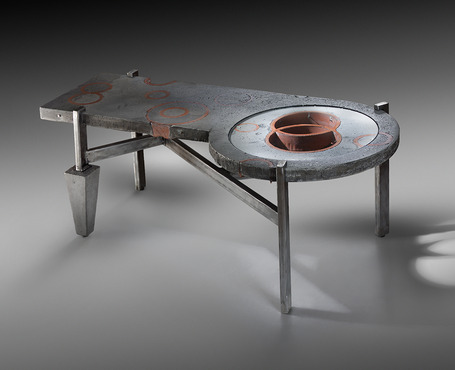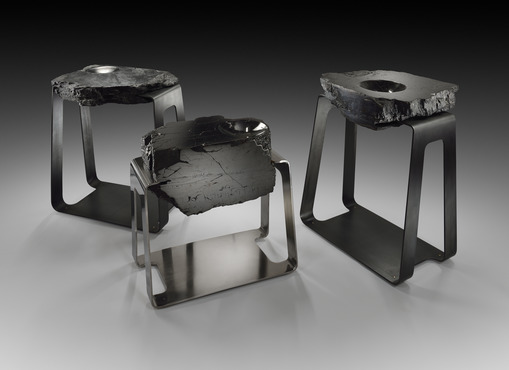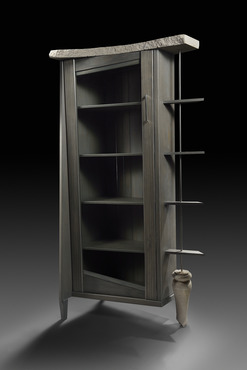
News . Feature Stories . Free for the making
News
March 28, 2018
Free for the making
Director builds community around fab studios

By Karen Sandstrom
Freeland Southard was 24 and had an associate’s degree and a full-time job when he came to CIA to study ceramics. He made a living with his carpentry business to support himself while he worked on his BFA. For three years, he averaged a little over four hours of sleep each night.
“I wouldn’t recommend it to anyone,” Southard says. “But it can definitely be done.”
“It can definitely be done” is Southard’s approach to life. He earned his BFA in 2005, and went on to the Herron School of Art and Design in Indiana for his MFA.
These days, “Free,” as he's called, is director of CIA’s fabrication studios, the shared shop for fabricating wood, welding, plaster and stone, plastic and other materials. The role requires an attention to detail and technical chops, but Southard also operates with the big picture in mind: The collaborative environment there should challenge students to think beyond perceived limits.
Southard was born with the figure-it-out gene. He exudes the enthusiasm of a kid at the top of a sledding hill and the focus of a medieval scribe.
He spent much of his childhood in Geauga County, Ohio, living what sounds like an idyllic life full of outdoor exploration. His mother was a teacher’s aide with some art school under her belt. His father was a machinist. “I grew up playing in his sawdust from working on houses,” Southard says.
“When I was in high school, I figured it out,” he says. “If I got all my chores done by noon, the rest of the day was mine. I had a dog, he was a golden lab. He was about 120 pounds. His name was Rook. Smart dog. Really smart. And he loved to go for bike rides.”
Chores in the morning; long bike rides on country roads with Rook on a leash in the afternoon. “We hit up some of the parks. We had Hell Hollow around the corner, and Paine Falls, Thompson Ledges,” he says. “It was nice to have the freedom to wander and explore. There’s nothing like wondering what’s around the corner.”
At 19, an age when some people are still borrowing Mom’s credit card, Southard had an associate’s degree, a full-time job in construction, and was buying his own condo. “I was trying to be a responsible human being. Then life happened. I had a relationship, and I thought it was going to get really serious, but it didn’t.”
Instead, he signed up for a ceramics class at Lakeland Community College, where he had earned his associate's degree. “It was just nice to sit down and take a hand-building class, and do some wheel throwing, and just be a part of that creative side,” he says.
His instructor, Katsue Zimmerman, was a 1999 CIA alum. She took Southard and one other student to CIA for a visit during BFA week. Southard was hooked. “I can do this?” he thought. “How do I get there?”
At CIA, Southard majored in ceramics because it was a familiar medium and he liked how ceramicists approach the work. “There is a sense of community among ceramicists that has always been there. It was nice, and it made sense.”
After he graduated, he went back to work for a while, and married jewelry artist Susan Skoczen. (The couple are now the parents of two sons and a daughter). Skoczen got a job at Indiana University. That put the couple close enough for Southard to go for his master’s degree at Herron School of Art and Design.
As much as he liked ceramics, he also liked working at a larger scale. He saw that furniture was a way to work larger and still make artwork that people welcomed into their homes.
In his practice, he goes for the unexpected. For his coffee table “Peg Leg,” Southard incorporated circles of ceramic in a steel tabletop supported by steel bars—one of which ends in a heavy trapezoid. He made a suite of tables with curvy steel bases supporting planed chunks of coal into which he set hollowed-out bowls lined with brass. He likes figuring out how to bring unlikely elements together and make them work in an unexpected way.
His dream project, he says, would be “to make the most complicated piece of furniture I could think of: custom hardware, customer driver bits for the hardware, custom tooling to build the thing, soup to nuts. Imagine an armoire made out of different flavors metal, wood, stone, glass, everything—as complicated as a watch. That, to me, would be a good time.”
Southard and Skoczen moved back to Northeast Ohio in 2015, and he took over the CIA fabrication studios.
“When I hired Freeland, the shop was in the middle of a construction plan that had changed at the last-minute to improve the ventilation capabilities,” says Chris Whittey, Senior Vice President of Faculty Affairs. “He walked into, basically, a huge mess: tools, equipment, workers all over the place, and the beginning of the semester mere weeks away. In no time, Freeland helped equip and arrange the best shop I’ve ever seen at an art and design college — and I have seen plenty — and he assembled a masterful team of technicians whose skills are second to none.”
Southard isn’t technically on faculty, but he’s a natural coach and teacher. He believes the fabrication studios should play an essential role in a CIA education.
“I want to develop a community in that shop space—makers sharing ideas, coaching each other, problem solving together, and getting to the point where if you’re not working on your project, students are calling each other like, ‘Where are you? I haven’t seen you in the shop.’
“As a maker, I feel like I work in Disneyland,” he says. “So why wouldn’t they want to be in there?”
Latest Headlines view all
-
April 02, 2024
Cleveland Institute of Art students partner with Progressive Art Collection to exhibit Ready, Set, Relay! -
March 04, 2024
Cleveland Institute of Art announces Curlee Raven Holton Inclusion Scholar Program -
November 06, 2023
Collision of art and artificial intelligence creates murky waters for artists, curators and educators
Questions?
For more information about this or other CIA news, contact us here.





Social Feed